
Widex Zen Therapy: What's new?
If you have been around for a while, you might have heard about Widex Zen Therapy, a tinnitus management tool that was developed by Widex, which was introduced in 2012.
Widex was the first hearing aid manufacturer (and still is!) to offer a full tinnitus management protocol. These days, however, there are so many various tinnitus treatment options out there, some offered by hearing aid manufacturers, others outside of the industry. It can be confusing, especially for a hearing care professional who decides to add tinnitus management as part of their services.
Where should one start? Who has an app? Do all the hearing aid manufacturers have sound generators? And what about the companies outside of the hearing aid industry? What options are available?
I can relate to these feelings of confusion. While this article is not intended to compare all the various options out there, I will try to demystify Widex Zen Therapy, by presenting a brief introduction to what Widex Zen Therapy is. Then, I will discuss our latest offerings, which includes the new Widex Zen Therapy – Tinnitus Management App.
Tinnitus facts
First, let’s review some tinnitus facts. We know that many people suffer from tinnitus. The American Tinnitus Association states that over 50 million Americans have experienced tinnitus. In fact, many people experiencing tinnitus also have some degree of hearing loss; however, they may not be aware of the hearing loss, or it isn’t their primary concern – the tinnitus is.
When a hearing loss is present, whether measurable on the audiogram or not, it means that there will be reduced neural activity eventually reaching the auditory cortex. The consensus about the origins of tinnitus is that this lack of stimulation (auditory deprivation) due to the hearing loss will cause the brain to overcompensate for the lack of stimulation, by causing extra activity/neural impulses in the brain, which the brain then interprets as sound.
Many people who experience tinnitus will be able to naturally habituate to it. Habituation as a general sense just means that one can get used to a stimulus after repeated exposure to it. We habituate to all kinds of sounds during our daily lives. An example of habituation could be wearing a watch, or no longer being bothered by traffic noises, if living in an area of heavy traffic. However, some tinnitus sufferers are not able to habituate to their tinnitus, and this can start affecting their quality of life.
This brings me to the main goal of Widex Zen Therapy (WZT): to give hearing care professionals the tools to help their clients improve their quality of life, with the end goal being to achieving habituation. WZT offers a structured, step-by-step protocol to help clinicians help their own clients manage their tinnitus.
Zen tones
Before we get to the process of WZT, let’s talk about the Zen tones. They have been around for a while, and if you fit hearing aids, perhaps you have even used them with your clients. But what makes them so special? The tones, as the name might imply, were first introduced to offer the possibility of activating a relaxation program in Widex hearing aids. What was special about these tones is that they were based on musical properties. Music can induce relaxation, by eliciting a physiological response; but on the other hand, music can also stir up negative emotion. Music can grab our attention – and while in some cases this might be good (or annoying, in the case of an earworm!), in the case of tinnitus management, we want tinnitus patients to achieve habituation.
To achieve habituation, we need to ensure that the person listening to the tones doesn’t get hooked on them. That is, we want them to listen to the Zen tones, passively, as opposed to actively. So, for that reason, Zen tones were designed using fractal technology, and they mimic the properties of music, the musical “rules”, so to speak – but without being predictable, or eliciting emotion. Fractals can generally be defined as something with a never-ending pattern, so when applied to Zen tones, it means that the melody generated will never be exactly the same. This is a fairly innovative solution.
Fast forward to a few years later: with the success of the Zen tones with tinnitus management, Widex decided to build a full tinnitus management protocol, of which the Zen tones would be an integral part. At that time, having a full tinnitus management protocol was an offering that hearing aid manufacturers lacked. Since sound stimulation is such an important part of managing tinnitus, it made sense for Widex to develop a protocol and to incorporate the fractal sound generator (the Zen tone, of course) in the hearing aids themselves.
Therefore, Widex teamed up with Dr. Robert Sweetow, an expert in the field of tinnitus management, and Widex Zen Therapy was born. Widex Zen Therapy is also known as an integrated tinnitus management protocol, because it integrates four individual components, which can be utilized all together, alone, or in any combination; as long as it meets the client’s needs. So let’s look into this in more details.
Widex Zen Therapy
As mentioned before, the main objective of the Widex Zen Therapy protocol is to ensure that tinnitus does not negatively affect the client’s quality of life. How to achieve that? Well, let’s look at the four components of WZT:
- Counselling
- Amplification
- Zen tones
- Relaxation
Depending on the needs of the patient, the clinician can assess which of these components should be part of the treatment plan.

Figure 1: The four WZT components
When tinnitus sufferers make their way to their hearing care professional for guidance about what to do about their tinnitus, they may have varying degrees of “reactions” regarding their tinnitus. Some may have a very strong negative reaction, but many will just be slightly or moderately bothered by it.
To uncover this, the first step that the clinician should take is to interview the client, using the Widex Intake Questionnaire, a tinnitus subjective questionnaire (for example, the Tinnitus Functional Index, questionnaire). Most importantly, the clinician should then discuss with the client, to determine how much the tinnitus is affecting their quality of life. For clients who don’t have a significant emotional reaction, instructional counselling about the origins, cause and course of the tinnitus, plus amplification (if a hearing loss is present and they want to try a hearing aids, might be enough.
The hearing aid will provide some sound stimulation, which helps reduce the contrast between their tinnitus and the silence, and for some people it might be enough to start pathing the way towards habituation. Others might have a stronger negative reaction and may be feeling stressed or anxious, and get caught in the vicious tinnitus-stress cycle.
The hearing care professional will be able to help them break the cycle, by providing appropriate counselling, amplification and relaxation strategies and possibly adding a Zen program in the hearing aid, if a hearing aid is deemed beneficial. For clients who require more structured counselling, WZT guides the clinician on how to conduct adjustment based counselling, in the form of Cognitive Behavioral Intervention (CBI). For those interested, a short course on CBI can be found here.
5-step approach to managing tinnitus
When we first introduced WZT in 2012, the package included a very complete and comprehensive manual, co-authored by Dr. Robert Sweetow and Anne-Mette Jeppesen. Where the original manual is excellent as a reference book for the details of WZT, there have been many requests for a shorter introduction to Widex Zen Therapy. In order to accommodate these needs, we now have an abridged version of this Widex Therapy Manual (with Dr. Sweetow’s seal of approval), in which we suggest a 5-step approach to managing tinnitus:
The Widex Zen Therapy 5 Easy Steps:

Figure 2: Widex Zen Therapy - 5 Easy Steps
The protocol itself has not changed – but the approach we take to teach others how to use WZT has been simplified. It is a shorter manual, with clear, concise steps (as seen in the figure above). For those who would like to get the full version of the manual, it is of course it still available. Both manuals can be found on the Widex LEARN educational site.
The WIDEX ZEN – Tinnitus Management app
Finally, the most exciting part of the updated Widex Zen Therapy is our new app, the WIDEX ZEN – Tinnitus Management app. This app can be used in two ways: as an educational/sound stimulation tool or as a supplement to the treatment plan. In the first case, the app can help reach those who have tinnitus but who either don’t have a hearing loss or have not yet made the step yet to treat their hearing loss, for whatever reason that may be. In the second case, it can be used by the tinnitus practitioner as an extra tool in the treatment plan.
The app contains new sounds, including new Zen tones, exclusively found on the app. It also contains a shop finder, making it easy for tinnitus sufferers to find qualified tinnitus practitioners in their area, if/when they are ready to take the next step. Finally, the app also contains general information on tinnitus, relaxation exercises and sleep management exercises, each with Frequently Asked Questions sections.

Figure 3: The Widex Zen - Tinnitus management app
The app is currently available in selected countries, and is on its way to others. To find out if the app is available in your respective country, please check your App Store/Google Play store, or ask your local representatives. To download the new manual, clinicians are invited to visit the Widex LEARN education site.
This article discussed Widex Zen Therapy, a tinnitus management protocol developed by Widex and Dr. Robert Sweetow. WZT is an integrated tinnitus management tool and consists of four core components: Counselling, Amplification, Zen tones and Relaxation. With the success of WZT, Widex wanted to expand the offering by introducing a new abridged manual for the hearing care professional, as well as an app: the Widex Zen Therapy – Tinnitus Management App.
For more information, please visit the Widex website or contact your local Widex representative.
Andrée Boissonneault is an Audiological Specialist at Widex. Her background in audiology includes audiological research, clinical work, and experience with several hearing aid manufacturers. She lives in Copenhagen, Denmark.